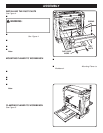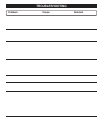
Page 13
ON
OPERATION
GETTING STARTED
Before turning on the planer, check for loose fasteners,
fittings, or hardware. Be sure the dust cover is securely
mounted and that the blade cutter rotates freely.
Lower the cutter head assembly to approximately 1 in.
(25mm) above the planer table surface. Without putting any
load on the planer, test the motor by turning the planer on and
allowing it to reach full speed. If the planer sounds exces-
sively loud or has excessive vibration, turn off the machine
immediately and check again for any loose hardware, re-
tightening any you may find.
THICKNESS PLANING
Thickness planing sizes workpiece to desired thickness
while creating a smooth, level surface. Thickness of each
cut will depend on type of wood (hardwood versus soft-
wood), width of workpiece, straightness, dryness, and
grain composition. Whenever working with a new type of
wood, make thin test cuts on a scrap piece of wood first
to determine potential problems with the workpiece.
PLANING
Thickness planers work best if at least one side of the
workpiece has a flat surface. When both sides of a
workpiece is rough, use a surface planer or jointer first to
define the initial flat surface. Plane one side of the
workpiece then flip the workpiece and plane the surface
of the reverse side.
Always plane both sides of a workpiece to reach the
desired thickness. This will leave the workpiece with
uniform moisture to prevent warp during the drying pro-
cess.
When one end of the workpiece is thicker than the oppo-
site end by more than 1/8 in. (3 mm), make several cuts
with the planer starting with light planing cuts first. Re-
member, light cuts create a finer finish than heavier cuts.
■ Do not plane a workpiece less than 3/16 in. (5 mm)
thick.
■ Do not plane a workpiece less than 3/4 in. (19 mm) wide.
■ Do not plane workpiece shorter than 14 in. (356 mm) long
as this will cause kickback.
■ Do not plane more than one workpiece at a time.
■ Do not lower the cutter head assembly lower than 3/16 in.
(5 mm)
Do not continuously use the planer set at the maximum depth
of cut (1/8 in., 3 mm) and at full width of cut (13 in., 330mm).
Continuous use at maximum cutting capacity will damage
the motor.
WARNING:
Never plane workpiece with loose knots or foreignobjects.
Do not plane workpieces that are severely bowed,
twisted, or knotted. Cutter blades can dull, chip, or
break causing possible serious personal injury.
Fig. 12
SWITCH KEY
OFF
. WARNING:
Always wear safety goggles or safety glasses with side
shields during power tool operation or when blowing dust.
If operation is dusty, also wear a dust mask.
Worn cutter blades will affect cutting accuracy. Planing with
dull or nicked cutter blades may produce ridges or rough
workpiece surfaces.
Gum and pitch on the cutter blades will cause them to wear
prematurely. Using a gum and pitch remover to keep your
cutter blades clean will prolong their wear.
Refer to the
Maintenance Section
of this operator's manual
for instructions on how to remove and replace or turn the
cutter blades.
Note: Cutter blades are double-edged and can be turned
once to the opposite, unused edge before replacement is
required. Cutter blades must ALWAYS be replaced as a set.
LOCKING THE SWITCH
See Figure 12.
■ Wait until the planer has come to a full and complete stop.
■ Place the switch in the OFF position, remove the switch
key from the switch assembly. Store key in safe place.


















